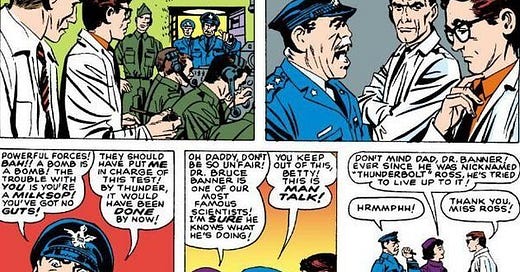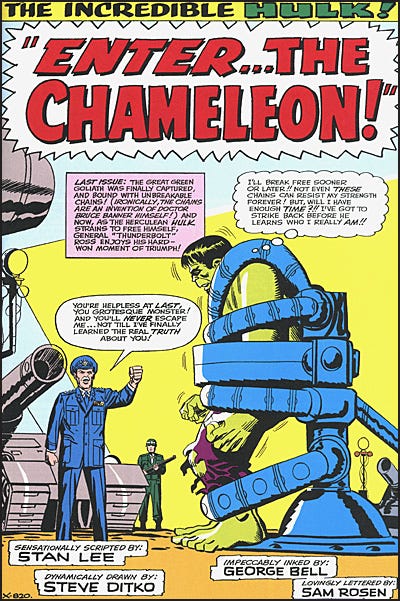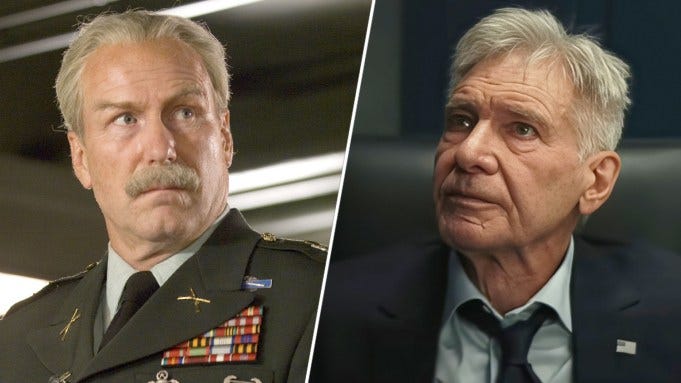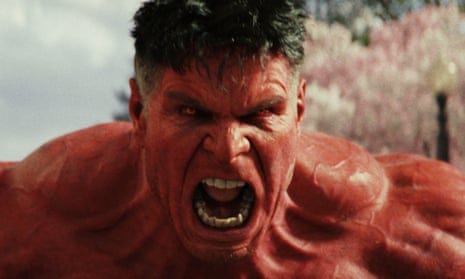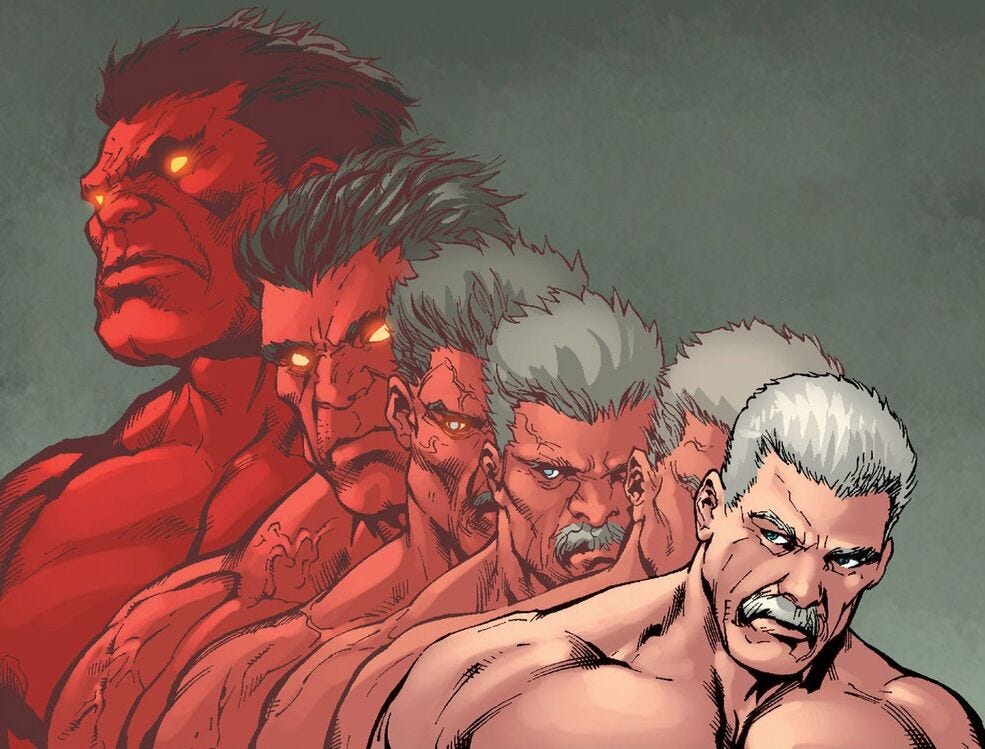In reading about “Captain America: Brave New World” before it opened, it seemed odd that several characters in the film — General “Thunderbolt” Ross, his daughter Betty Ross, and the Leader — were characters primarily associated with the Hulk in the comics. Moreover, the Hulk was not in the movie. What was going on here?
The two Rosses had been in the first “Hulk” movie, the 2003 film directed by Ang Lee for Universal, which then held the movie rights to the Hulk. In that film Eric Bana played the Hulk’s human alter ego Bruce Banner, “Thunderbolt “ Ross was played by Sam Elliott and Betty was played by Jennifer Connelly. That film is not part of Marvel Cinematic Universe continuity. (Paid subscribers can read my columns commenting on that movie.)
When the movie rights to the Hulk reverted to Marvel, Marvel Studios produced the second “Hulk” film, “The Incredible Hulk,” which came out in 2008, only five years later. This was effectively a reboot, starting the Hulk’s story over again with a new telling of his origin. This time Mark Ruffalo played Banner, William Hurt played General “Thunderbolt” Ross, and Liv Tyler played Betty. This film also introduced Tim Blake Nelson, playing Samuel Sterns, a scientist who was exposed to gamma radiation and began mutating. It would not be until 2025 and “Captain America: Brave New World” that we would learn what Sterns mutated into.
It does seem strange that a Marvel Studios film would reach back seventeen years to follow up on an old plot thread and bring back a villain for a new movie. But I like the idea. I have always been fascinated by Marvel Universe continuity, and love the way that everything in the Marvel Universe in the comics ties together. Marvel Studios recognizes that this continuity is one of Marvel Comics’ strengths, and has created its own version in the Marvel Cinematic Universe.
Various reviewers have complained about bringing back a character from seventeen years ago whom they understandably did not remember. But I don’t think it’s a problem. If you pay attention to the film, it explains who Sterns is and why he hates “Thunderbolt” Ross. Bringing back Sterns serves as a reminder to aficionados of the Marvel Cinematic Universe that all the movies are tied together, so they should watch them all. But more casual viewers need not watch everything, since “Brave New World” supplies them with all the information they need to understand who Sterns and other characters from previous films and shows, like Isaiah Bradley, are.
The fact that Marvel Studios remembered Sterns and brought him back may also serve as a welcome sign that other characters whom the films have briefly introduced may indeed play roles in future Marvel projects. Similarly, the Beast made a surprise appearance in the credits sequence for “The Marvels,” and subsequently it has been revealed that he will return in “Avengers: Doomsday.”
Who else is on the waiting list for returning to the MCU? For example, Clea shows up in the credits sequence for “Doctor Strange in the Multiverse of Madness.” Hercules turns up in the credits sequence for “Thor: Love and Thunder,” as Zeus vows vengeance on the thunder god. At the end of “Eternals” Eros a.k.a. Starfox and Pip the Troll appear in the mid-credits sequence, and Dane Whitman seems to be on the verge of becoming the Black Knight from the comics in the post-credits sequence. Will any of them return in future Marvel Studios movies and television series?
Maybe not. Maybe Marvel Studios was being overly confident in introducing all these characters. For a long time it seemed as if Marvel Studios could make any of its movies into huge successes, even those with lesser known characters like Ant-Man and the Guardians of the Galaxy. And for a while Disney was pushing Marvel to have a nearly continuous flow of new series on Disney+. But Marvel Studios had apparently overextended itself, and its movie and television output over the last several years has been uneven artistically and disappointing commercially. Now, I expect, Marvel Studios has to be choosier about what movies and TV shows they make. There are reports that Marvel Studios is developing a third “Doctor Strange” movie, so we may well see Clea return. But will there be a fifth “Thor” movie? Will we ever get to see more of Starfox and Pip, or any of the Eternals, or ever see Dane Whitman become the Black Knight? It remains to be seen. But the return of Sam Sterns suggests that anything is possible.
In the comics, General Thaddeus “Thunderbolt” Ross goes all the way back to the first Hulk story, in “The Incredible Hulk” #1 (1962) by Stan Lee and Jack Kirby. Ross is the Air Force general in charge of the test explosion of Dr. Bruce Banner’s gamma bomb. He is also the father of Betty Ross, to whom Banner finds himself attractive. General Ross is hot-tempered, demanding, domineering, seemingly constantly angry. He has contempt for Banner, whom he calls a “milksop” and regards as insufficiently masculine by his standards. “Thunderbolt” Ross is himself an example of toxic masculinity. He is also very much the “heavy father” figure who stands in the way of Banner’s potential romance with Betty.
When the Hulk first appears, “Thunderbolt” Ross, initially unaware that the Hulk is the transformed Banner, sees him as a menace and launches his years long campaign to capture or destroy him. Over the course of the decades in real time that followed, Ross became Marvel’s analogue to Captain Ahab, and the Hulk was his white whale. Traditionally, the Hulk prefers to be left alone, but it is Ross who insists on hunting him down, thereby provoking the Hulk’s rampages. Famously, when Banner becomes angry, he turns into the Hulk, the living embodiment of rage. Yet Ross himself is driven by obsessive rage against the Hulk. Ross and the Hulk are thus more alike than either recognizes.
There have been times when Ross and Banner / Hulk have been at peace with each other. But more often, Ross gives into his obsessive rage and hatred. This obsession has repeatedly led Ross to violate his own duty as a soldier and to collaborate with such menaces as the Leader, the Abomination and MODOK to defeat the Hulk. In “The Incredible Hulk” #319, written and drawn by John Byrne, Ross invaded the wedding of Bruce and Betty in an attempt to kill Banner. Ross shot Bruce’s longtime friend Rick Jones instead and was unable to stop the wedding.
As for “Thunderbolt” Ross in the movies, it’s not the case that he hasn’t had an important role to play in the MCU since “The Incredible Hulk” in 2008. He has kept turning up in the MCU films over the years. But Ross’s focus in the movies has turned from the Hulk to the Avengers. Ross’s contention with them never became obsessive, but for years he seemed to be implacable.
Ross became Secretary of State, and as such, became an adversary of the Avengers in “Captain America: Civil War” (2016), forcing them to comply with the Sokovia Accords, which put them under United States government control, and taking action against those who refused. Ross is the person responsible for imprisoning Avengers such as Hawkeye, Ant-Man and the Falcon, who defied the Accords, in the prison for superhumans called the Raft. In “Black Widow” (2021), set between “Civil War” and “Avengers: Infinity War,” Ross is hunting down the Black Widow, one of the Avengers who rebelled against government control. In “Avengers: Infinity War” (2018) James Rhodes, a.k.a. War Machine, defies Ross by refusing to turn in Captain America and other rebel Avengers, and Rhodes predicts that he will be court martialed as a result.
Then Ross’s storyline becomes somewhat puzzling. “Infinity War” ends with Thanos wiping out half the living beings in the universe. Although the Marvel movies never explain this, it appears that Ross and the United States government drop their charges against the Avengers. In “Avengers: Endgame” (2019) we see that the Black Widow and Captain America, both formerly fugitives from the law, are back working at the Avengers Compound. There is no indication that they are subject to government supervision. Towards the end of the movie Ross attends the memorial for Tony Stark. All of the Avengers are present, but he takes no action against any of them.
I wish that Marvel Studios had explained this change. Did Ross decide when half the population was obliterated that jailing Avengers was no longer important? Did the United Nations repeal the Sokovia Accords, reasoning that they now needed the Avengers to deal with this crisis and was willing to allow them freedom of action?
Whatever the case may be, I expect that after the Avengers succeeded in resurrecting all of the people whom Thanos had disintegrated, the world was so grateful to them that punishing them for past violations of the Accords was out of the question.
In “Captain America: Brave New World” “Thunderbolt” Ross has been elected President of the United States. For decades Marvel and DC stories treated whoever was President in real life as the President in their fictional universe, probably with the intent of making their fictional world seem more like the one in which the readers lived. But in recent years this has changed, perhaps because writers and editors assume that the readers see the comics’ world as an alternate reality. And so Lex Luthor became President in the comics, and the Kingpin became mayor of New York City in the comics. This approach has carried over into the Marvel Cinematic Universe, in which the Kingpin has also become New York City’s mayor. Marvel’s Disney + series “Secret Invasion” (2023) established that there was a President Ritson, and predicted that he would soon be supplanted by a new president. That happens in “Brave New World” when Ross becomes President.
Ross’s attitude towards superheroes has now considerably changed. Apparently as a result of the Avengers’ success against Thanos, Ross now regards the Avengers positively. Even though Ross had previously had Sam Wilson imprisoned at the Raft, he now invites Sam, the new Captain America, to the White House and proposes to him there that he revive the Avengers as an active team.
Ross has changed in a different way, too: following the recent death of William Hurt, Harrison Ford has taken over the role of “Thunderbolt” Ross. Amusingly, the difference in the way that Ross now looks is explained in the film by having Ross say that he shaved off his mustache for his election campaign.
I like that Ford is now playing Ross. Ford is already a popular culture legend for playing Han Solo in the “Star Wars” universe and Indiana Jones in five films. So it’s a welcome turn of events that Ford now brings his iconic presence to the Marvel Cinematic Universe as well. He has also played a forceful president in the 1997 film “Air Force One,” so that is surely in the back of many viewers’ minds as they watch him play a different President in “Brave New World.”
Moreover, “Brave New World” goes back to the idea that Ross himself is an embodiment of rage. In this movie Ross is continually struggling to restrain his tendency to anger as crises put increasing amounts of pressure and stress on him. Watching Ford’s performance I sense anger more strongly than I ever did with Hurt in the role. Since Marvel Studios has chosen to probe Ross’s dark side, his potential for rage, it works better with Ford in the role.
Best of all, Ford’s powerful and iconic screen presence easily makes him a second protagonist in the film, alongside the title hero, Sam Wilson as the new Captain America.
My biggest problem with “Brave New World” is that the movie seems to come to a climax and an ending when Captain America thwarts the Leader’s scheme to start a war between the United States and Japan. And then the movie has to start up again with a final act in which the stress that President Ross has been under reaches a peak and transforms him into the Red Hulk. There has been controversy over Marvel Studios giving this plot point away in its advance publicity for the film. Indeed, when you watch the movie, it does seem that Ross’s transformation into the Red Hulk was intended to come as a surprise, just when the viewers might assume that the movie was over.
Nonetheless, readers of “Hulk” comics in recent years would have known that Ross became the Red Hulk, and anyone who Googled “Red Hulk” would have discovered this fact, too. (I was surprised to learn that there are now two Red Hulks in the comics. This seems to be yet another example of superhero comics taking unique characters and then imitating them over and over. No, I don’t like the infinite number of Spider-Men we now have in the comics and cinematic Spider-Verses. But that’s another story.) So maybe it did make much sense for Marvel Studios to keep Ross’s metamorphosis into the Red Hulk a secret. Certainly publicizing the introduction of a new Hulk in the new Captain America movie helped foster audience interest in seeing the film.
In the comics, as I have noted, in his obsession with battling the Hulk, “Thunderbolt” Ross has joined forces with super-villains who are likewise the Hulk’s enemies. So in 2008 the Intelligencia, a cabal of genius super-villains including te Leader, turned Ross into the Red Hulk.
It has been observed that a person who is consumed by a desire for vengeance against a “monster” of evil risks becoming evil and monstrous himself. So it is perfectly ironic that after so many years of seeking to capture or destroy the Hulk, that “Thunderbolt” Ross would become a Hulk himself. The red color seems appropriate to Ross’s own fiery rages.
But the irony is less evident and less dramatically powerful for the Marvel Cinematic Universe version of “Thunderbolt” Ross, because we haven’t seen him oppose the Hulk since the 2008 “Incredible Hulk” movie. He’s been the Avengers’ adversary instead.
In the comics the Red Hulk proved to be so popular that Marvel evolved him into a superhero. This is another trend in superhero comics that I dislike. I liked it when in the 1960s, Hawkeye, Quicksilver and the Scarlet Witch were all introduced as villains, but Stan Lee and Jack Kirby turned them into heroes and members of the Avengers. But those three characters had never been depicted as truly evil. Quicksilver and the Scarlet Witch were serving Magneto out of gratitude for his saving their lives, and Hawkeye was blinded by his love for the Black Widow, who was then a Russian spy. The Black Widow’s own evolution into a superheroine was well handled by Stan. In later years the reformations of the Banshee and Rogue and Nighthawk were done well. But other attempts to turn villains into heroes haven’t worked for me. Not Magneto, not the Juggernaut, not the White Queen, and certainly not Venom. Deadpool started out as a villain and I have never felt comfortable about him as a superhero, although Ryan Reynolds’ performance has won me over to his cinematic counterpart.
In the comics the “Thunderbolt” Ross Red Hulk has even headed the Thunderbolts team. So finally there was a connection between “Thunderbolt” Ross and the similarly named Thunderbolts! Presumably there won’t be in the Marvel Cinematic Universe.
At the end of “Brave New World” Ross is no longer President and is imprisoned at the Raft. So who is the President of MCU America now? Who was Ross’s Vice President? And will we ever see Harrison Ford’s “Thunderbolt” Ross in the MCU again?
But if this is the end of “Thunderbolt” Ross’s saga in the Marvel Cinematic Universe, it’s an admirable one, bringing his long story arc in the movies to a satisfying conclusion. This is the sort of use of continuity that I admire in both Marvel’s comics and movies, drawing upon a rich history to illuminate characterization.
Similarly, although Marvel’s “Eternals” movie was disastrous and there is no sign yet that Marvel Studios will bring back any of those characters, I like that the film has made a lasting contribution to Marvel Cinematic Universe continuity. The conflict between the United States and other nations in “Brave New World” is over the body of the Celestial named Tiamat from the “Eternals” movie, which has introduced adamantium to Earth. This surely is a set-up for a future “X-Men” movie, since Wolverine famously has a skeleton laced with the nearly indestructible adamantium.
And though Ross is no longer President, his plan to have Sam Wilson rebuild the Avengers will surely go forward, since “Avengers: Doomsday” will come out in 2026.
